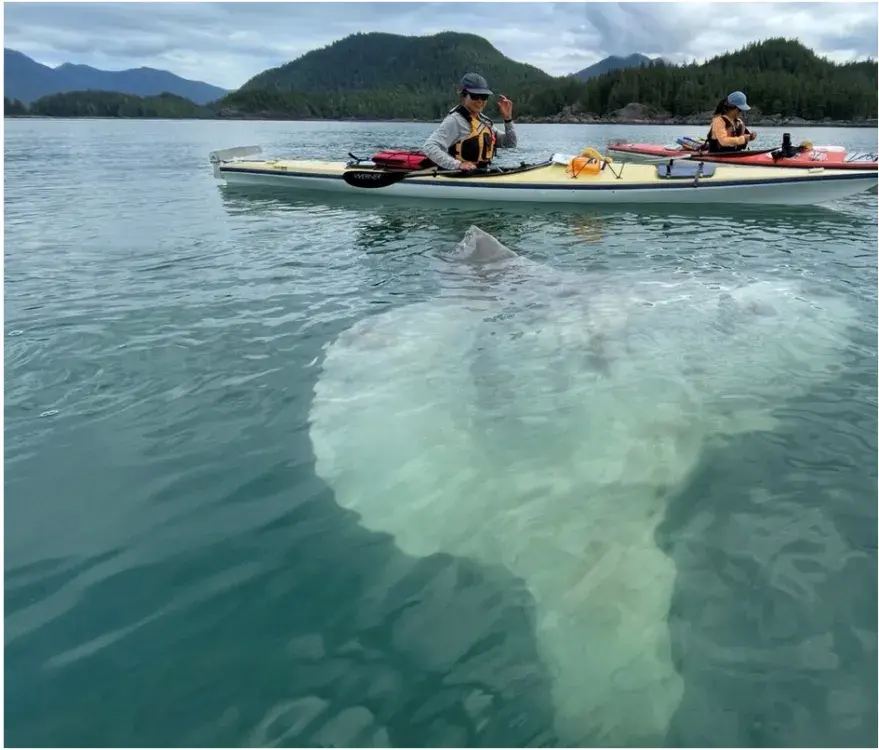This August kayakers in Kyuquot Sound were astonished when they paddled upon a giant ocean sunfish.
Tashi Townley, his partner Megan Komori-Kennedy and her mom Violet Komori are still processing what they saw during their last-minute kayak trip.
“It was so surreal. Basically we pulled up on this fin and we initially thought it was maybe a sea lion sleeping on its side and its flipper was poking out of the water,” Townley said. “Then as we got closer there was this moment of just complete uncertainty and it took about 10 seconds for it to sink in that it wasn’t a sea lion and it was actually this massive fish flapping in the current. There’s not really many words that can describe seeing such a large fish.”
Townley, who splits his time between Vancouver Island and B.C.’s interior, said this was his first time paddling around Kyuquot, but his partner and her mom have been coming to the area for years. None of them had seen a giant sunfish before, but the ironic part is, they were all talking about how surreal it would be to see one 30 minutes before the encounter.
“We were all paddling 18-foot kayaks, and [the sunfish] had to be at least half the length of our kayaks and probably close to that in width as well. It was probably the size of a small car,” Townley said. “To me they seem like these mythical creatures.”
Townley said he had a rough idea of what the giant fish was but it was his mom who suggested he submit the photo to the Marine Education & Research Society (MERS).
The giant sunfish that Townley paddled upon was a Mola Mola, one of two different sunfish species showing up along the Pacific Coast that MERS is collecting data on.
Along with ocean surveys and working with partners like Fisheries and Oceans Canada, MERS relies on citizens to submit photos or videos of Mola sightings in waters on the coast from California to Alaska.
The other Mola species found in West Coast waters is the Mola Tecta, also known as the hoodwinker sunfish, because until recently it’s been misidentified as the Mola Mola and has gone undetected.
Jackie Hildering, education director with MERS, said Molas are not uncommon or rare, but there’s been little dedicated research on the species, especially the Mola Tecta.
“Our role in it as the Marine Education Research Society is to try to use our networks to get more sightings,” Hildering said. “There’s been more research done in California because it’s warmer and [Mola’s] are more common there, but there’s not been a lot of research done certainly in Alaska and in B.C.”
Hildering said research and data collection on the two Mola species showing up in the Northern Hemisphere began to pick up steam when a blog post she wrote in 2011 on what she presumed was the Mola Mola caught the attention of marine scientist Dr. Marianne Nyegaard.
Nyegaard published her discovery of the hoodwinker species in 2017, which she first identified in waters off New Zealand four years prior. Nyegaard believed the temperate Southern Hemisphere was where you’d find the hoodwinker species until a dead one appeared on a beach in San Diego, California in 2019. After that she began searching the internet for any blog posts or citizen photos on social media of the species being spotted on the other side of the world.
Nyegaard found that it was common for hoodwinkers to be misidentified along the western coast of North America. Tracking how long this species has been living in Canadian waters is difficult because there’s not much data before the beginning of social media.
“Presumption even by researchers on this coast was that they were all Mola Mola and with [Nyegaard’s] keen understanding of this new species, she thought wait, that’s not a Mola Mola and it was 6,500 kilometres further north than what was expected to be the range,” Hildering said.
Differentiating the Mola Mola and the Mola Tecta isn’t easy for the average person, but Hildering says through her research she’s often able to tell the two species apart, especially if they’re adult sunfish.
“Depending on the photo…if there is wrinkling on the skin, it’s almost certainly to be a Mola Mola and there’s an overall smoother appearance to the Mola Tecta,” she said. “If you can get a good look at their head, there’s no head or chin bump in the [Mola Tecta].”
Hildering said Mola Mola’s are known to get to be about 3.3 metres in size and there’s reports of them weighing up to 2,500 kilograms. She said females are believed to be bigger than males. There’s been far fewer sightings on the Mola Tecta and the biggest one known to date is 242 cm long and can weigh up to two tonnes.
There’s been more than 2,000 citizen submissions to date that MERS, along with Fisheries and Oceans Canada and partners in the U.S., have received on Molas.
“For us specifically, even for just this year, we have 60 data contributions in B.C. and a few are from Alaska,” Hildering said. “In terms of whatever we get randomly, if the number of sightings is big enough it should allow a sense of how many and where the two species are relative to one another. Otherwise it is really difficult. If we are getting more people engaged in one area of the coast versus the other than that is going to skew the results.”
Hildering said sightings off Vancouver Island are sometimes more common because of the same warm waters that bring in tuna. She said she’s seen sunfish near Port McNeill and there’s been sightings outside Haida Gwaii and offshore around B.C. It’s not yet known if sightings around B.C. are due to El Nino years or warming temperatures due to climate change.
“There has been the presumption that [Mola] are far slower and less mobile, which is wrong…they can dive really deep where it’s colder and they’re believed to come to the surface to warm up,” Hildering said. “They also present (at the surface) to be cleaned by birds like Alcatraz because they have parasites on the outside and it is why they are called, collectively, the sunfish, not for their shape but for this behaviour coming to the surface for sun.”
Hildering said for anyone who comes across the large fish, if they’re able to document it in some way without causing any stress to the animal, to please do so and submit any findings to mersociety.org.







